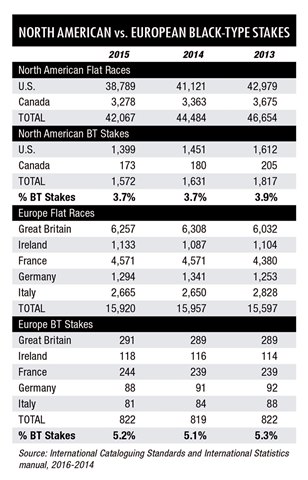Part 1: Evolution of Black Type


Part I of a two-part series on the development of the black-type system for identifying the world's best races and racehorses. The series originally ran in the July 16 and July 23 issues of BloodHorse.
For more than 30 years the international racing industry has wrestled with ways to quantify a Thoroughbred’s racing quality. The ultimate goal is a system that portrays the value of a given horse’s performance record consistently across all borders worldwide.
The highest standard of quality historically has been stakes races—open races with nomination fees paid by the participants. The designation of “stakes winner” prior to the 1980s, however, cast an extraordinarily wide net that included the winner of a $5,000 race in the Southwest or the winner of an American classic. The stakes winner label only carried weight if the racetrack hosting the race and the purse were also known.
Narrowing the broad quality gap among stakes winners started becoming a higher priority in the 1970s when the Thoroughbred auction markets began growing rapidly. Between 1945 and 1967, gross sales at Keeneland’s summer yearling sale fluctuated between $2.1 million and $5.9 million. In 1968 this sale set records for gross and average of $7,606,500 and $30,671, respectively. By 1980 the sale’s gross was more than $57.5 million and the average a jaw-dropping $200,425.
Along with the growth in commercial sales arose the need for standards across the world’s leading auction houses. The quality expressed by a horse’s catalog page needed to be the same whether the horse was being sold in Kentucky or England. To address this need, the International Cataloguing Standards Committee formed in 1981 followed by the Society of International Thoroughbred Auctioneers in 1983.
Identifying a method to highlight consistently the most important horses on a catalog page was among the key issues the ICSC and SITA would address first.
At this time, European racing authorities had in place for more than a decade a classification system that distinguished ordinary stakes from those with prestige. The better races, called group races, were assigned a I, II, or III rating, with ‘I’ being the best. The remaining ungraded stakes were identified as “pattern” races. North America adopted a similar grading system in 1973.
Also, Fasig-Tipton since 1952 and Keeneland since 1960 had been using bold-face type in their catalogs to identify stakes winners in a pedigree—all capital letters for stakes winners and mixed case for stakes-placed runners. The ICSC and SITA added to this convention by defining the specific races whose winners and placers would be entitled to “black type” identification in a sales catalog.
Both the grade/group ratings and black-type designations were driven by a common goal: to improve the breed by allowing breeders to evaluate racing class in stallions and broodmares in a reliable, consistent, and objective manner.
The introduction of black-type rules to North America in 1985 came with some controversy because not all stakes qualified for black type per the international cataloging guidelines.
Without debate, the industry worldwide accepted that graded/group races all qualified for the black-type designation. The debate then was how to classify the remainder of the stakes.
What had not been so readily accepted in North America were the following changes:
Awarding black type to allowance races, which had been proposed by an ICSC subcommittee chaired by Fasig-Tipton president John Finney, was the more controversial of the two rules.
“In North America, below graded races, the best single indicator of class of unrestricted races is the money for which the horses run,” read a statement from the ICSC as it announced the new rules.
These changes, Finney told The Blood-Horse in 1985, would more closely align the opportunity to earn black type in North America with that of Europe. According to the subcommittee, the higher volume of racing in the U.S. depressed the percentage of stakes races when compared with European flat races: 3.5% of U.S. races were stakes in 1985 compared with 6% in England, 5.5% in France, and 11% in Ireland.

The allowance/handicap designation was short-lived and would eventually apply only to North American racing in 1985. Starting in 1986, black-type rules in the U.S. and Canada were as follows:
• First through fourth-place finishers in graded/group stakes earned black type;
• Listed stakes, which are added-money races worth at least $50,000, award black type to the top three finishers and in a catalog must be accompanied by the racetrack abbreviation and purse money earned in the race;
• Other added-money stakes worth $15,000 to $49,999, run under restrictions or by invitation, awards black type to the top three. (The ICSC had already indicated in 1986 it would raise the minimum purse the following year to $20,000.)
• Restricted stakes were allowed black type provided the restriction was limited to the place of conception or foaling, location of sire or residence of the owner, or sold through a particular auction house. Restrictions of specified amounts of money or maximum claiming price were also allowed.
• Non-qualified races of $14,999 or less offer no black type.
These “non-listed” black-type stakes—other added-money races and restricted stakes—are now unique to U.S. and Canadian racing.
Over the years black-type rules would continue to be tweaked and further weed out lesser-quality races from eligibility.
In 1988 the minimum purse amount for black-type status was raised to $25,000 and took effect Jan. 1, 1990.
“Assuming that 1989 North American racing generally follows the pattern of 1988, the net effect of the change will be to eliminate ‘black type’ granted to about 550 races, which have an added-money value between $15,000 and $20,000,” Finney told The Blood-Horse. “It is the ICSC’s opinion that this reduction will make North American ‘black type’ standards more comparable to those of other racing nations. ‘Black type’ will be granted to about 10% of North American non-claiming races as compared with 13% under the old standard. About 6% of comparable races are granted ‘black type’ in the European racing countries.”
In 1990 the awarding of black type to fourth-place finishers in graded stakes had been dropped in North America and internationally.
Over the years the purse requirements have risen steadily. A $50,000 purse is now the minimum to be considered for black type, and a minimum of $75,000 must be offered to be considered as a listed stakes. Recognizing, too, that purse money is not a reliable indicator of quality, additional requirements for black-type status have been introduced. Beginning with the 2013 racing year, listed stakes are now evaluated annually and assigned black-type status by the American Graded Stakes Committee. Then in 2014 a quality control system for non-listed stakes was implemented and assigns every race a Race Quality Score. If a race’s three-year rolling average score and its most recent annual score fall below a minimum threshold, it loses its black-type status.
“I think the goal has always been that there be a level of uniformity in what the quality is and in the representation throughout the major sales companies (that are all SITA members),” said Carl Hamilton, chairman of the International Grading and Race Planning Advisory Committee. “It is an ongoing process, and we are always looking for ways to improve, but I think the process is working.”
Part II: Further efforts since 2012 to qualify North American black-type races through the evaluation of listed stakes and implementation of a scoring system for non-listed stakes.
